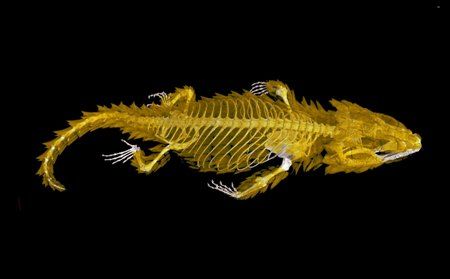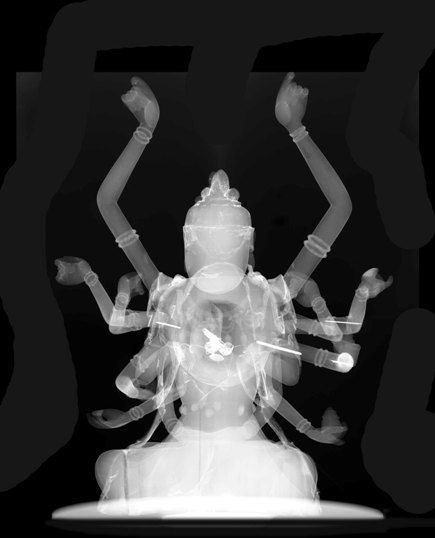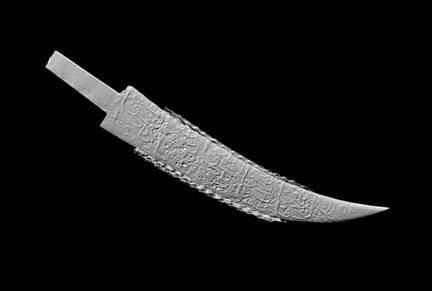Radiology’s Beauty on Display at American Museum of Natural History
"Picturing Science: Museum Scientists and Imaging Technologies," an exhibition of more than 20 sets of striking large-format prints, showcases advanced imaging technologies used by scientists at the American Museum of Natural History and reveals once-hidden, intricate details of both natural phenomena and cultural artifacts.
The beauty of the CT and the x-ray extend far beyond the diagnostic, a new exhibit opening Saturday, June 25 at theAmerican Museum of Natural History reminds us.
"Picturing Science: Museum Scientists and Imaging Technologies," an exhibition of more than 20 sets of striking large-format prints, showcases advanced imaging technologies used by scientists at the American Museum of Natural History and reveals once-hidden, intricate details of both natural phenomena and cultural artifacts.

Armadillo lizard with osteoderms
Edward Stanley, a doctoral candidate in the Comparative Biology Program of the Museum’s Richard Gilder Graduate School, uses CT scanning to view a lizard’s “osteoderms”-the bony plates of armor located in the animal’s skin. Stanley uses these features to map out the evolutionary relationships among species and investigate shifts in ecology within this morphologically diverse family of lizards.
©AMNH\E. Stanley
The exhibition, in the museum’s second-floor Akeley Gallery, explores how imaging technologies – including infrared photography, scanning electron microscopy, and computed tomography – make it possible to examine and analyze a range of specimens and phenomena at levels of detail previously unimaginable, advancing science and providing new insights into the visual splendor of the universe, museum officials say.
“When science and technology come together, the fruits are often beautiful and surprising, as this new exhibition so brilliantly demonstrates,” said Ellen V. Futter, the museum’s president. “New imaging tools allow us to present anew the intersection of science and art – both vital lenses through which, separately and increasingly together, we can better understand the world around us.”
The images in Picturing Science were taken as part of current research at the Museum, including studies of evolving supernovas, long-buried ancient villages, microscopic hairs on wasp antennae, biological fluorescence, and more. The exhibition features the work of 27 Museum scientists, students, and staff from the Divisions of Anthropology, Invertebrate Zoology, Physical Sciences, Vertebrate Zoology, and Paleontology, as well as from the Richard Gilder Graduate School. The images were produced with a range of optical tools and equipment, many of which are housed in the Museum’s Microscopy and Imaging Facility (MIF), which provides Museum research staff with opportunities to use advanced imaging technology.
The museum’s CT scanner is a crown jewel. Acquired by the Museum in 2010 with a grant from the National Science foundation, the GE Phoneix V/tome/x Dual-Tube CT Scanner is one of only four of its kind in the country.
“There is a nexus of aesthetics and science that too often goes unstated by us scientists to the public,” added Mark Siddall, curator of Picturing Science and curator in the Museum’s Division of Invertebrate Zoology. “This is a unique opportunity for researchers at the Museum to share their personal fascination with what they see in the course of their research.”
Picturing Science will be on view through June 24, 2012.

Tibetan wood figure
Museum conservators Judith Levinson and Karl Knauer use x-rays to investigate the condition of artifacts, including Tibetan deity figures. In the case of the wooden figure, the x-ray revealed previous repairs and ritualistic objects, known as consecration items, placed within a cavity inside the body.
© AMNH\J. Levinson and K. Knauer

Eygptian blade seen through sheath
Alex de Voogt, assistant curator in the Museum’s Division of Anthropology, used computed tomography to digitally “remove” a sheath from an Egyptian knife collected in the 1930s. The leather portions of the sheath had shrunk, making the sheath too tight to remove, while lead strips made the sheath impenetrable by conventional x-rays.
© AMNH\A. De Voogt
Could Lymph Node Distribution Patterns on CT Improve Staging for Colon Cancer?
April 11th 2025For patients with microsatellite instability-high colon cancer, distribution-based clinical lymph node staging (dCN) with computed tomography (CT) offered nearly double the accuracy rate of clinical lymph node staging in a recent study.
AMA Approves Category III CPT Codes for AI-Enabled Perivascular Fat Analysis from CT Scans
April 9th 2025Going into effect in 2026, the new CPT codes may facilitate increased adoption of the CaRi-Heart software for detecting coronary inflammation from computed tomography scans pending FDA clearance of the technology.
The Reading Room: Racial and Ethnic Minorities, Cancer Screenings, and COVID-19
November 3rd 2020In this podcast episode, Dr. Shalom Kalnicki, from Montefiore and Albert Einstein College of Medicine, discusses the disparities minority patients face with cancer screenings and what can be done to increase access during the pandemic.
Study with CT Data Suggests Women with PE Have More Than Triple the One-Year Mortality Rate than Men
April 3rd 2025After a multivariable assessment including age and comorbidities, women with pulmonary embolism (PE) had a 48 percent higher risk of one-year mortality than men with PE, according to a new study involving over 33,000 patients.
GE HealthCare Debuts AI-Powered Cardiac CT Device at ACC Conference
April 1st 2025Featuring enhanced low-dose image quality with motion-free images, the Revolution Vibe CT system reportedly facilitates improved diagnostic clarity for patients with conditions ranging from in-stent restenosis to atrial fibrillation.